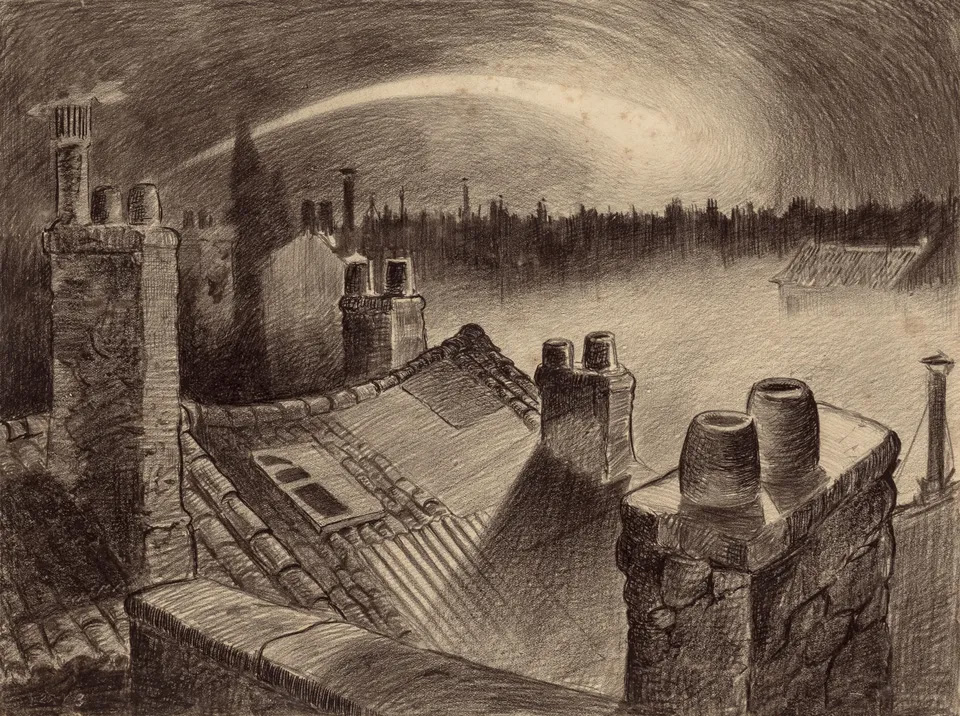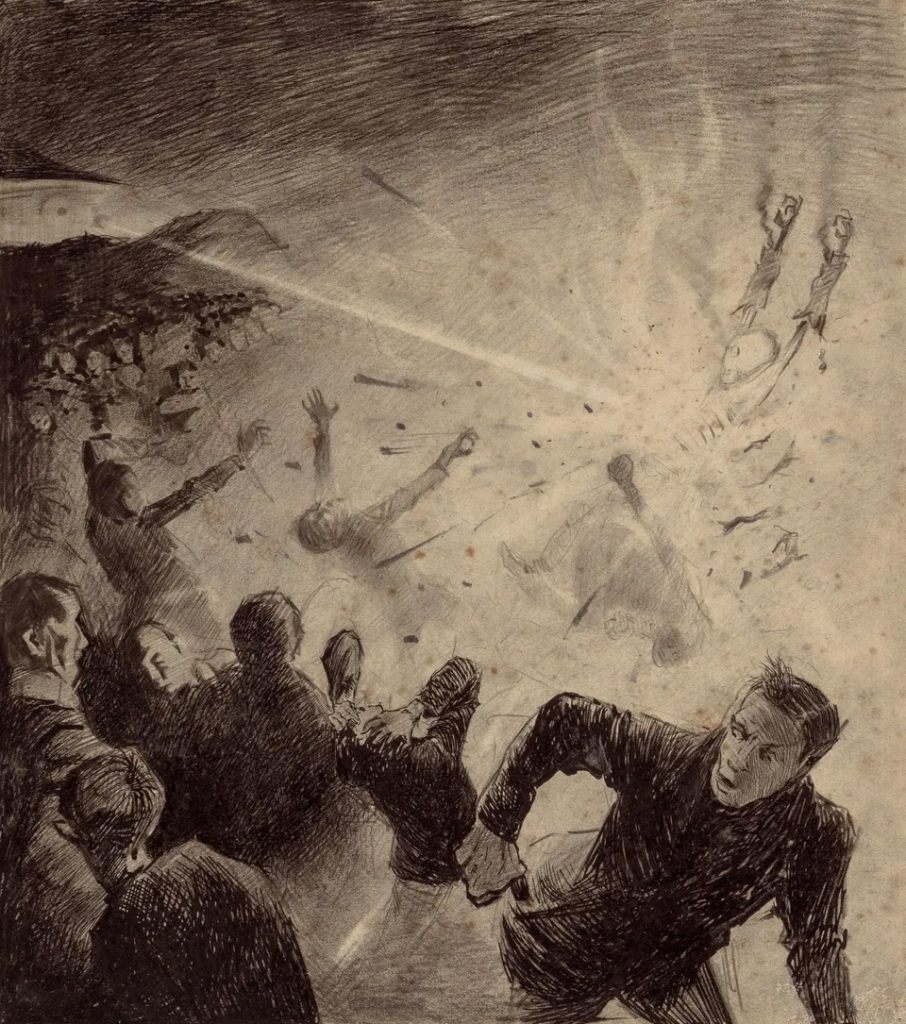Herbert George Wells
HG Wells was the author of the seminal work The War of the Worlds in which he documents his experiences during the Martian invasion. Born in Kent, on 21 September 1866, Wells died on 13 August 1946, aged 79, at his home overlooking Regent’s Park, London.
A prolific author he wrote more than 50 novels and dozens of short stories. His non-fiction output included works of social commentary, politics, history, popular science, satire, biography and autobiography.
In addition to his fame as a writer, he was prominent in his lifetime as a forward-looking, even prophetic social critic who devoted his literary talents to the development of a progressive vision on a global scale. A futurist, he wrote a number of utopian works.
Wells rendered his fiction convincing by instilling commonplace detail alongside a single extraordinary assumption per work – dubbed Wells’s Law – leading Joseph Conrad to hail him in 1898 with “O Realist of the Fantastic!”. His most notable science fiction works include The Time Machine (1895), which was his first novel, The Island of Doctor Moreau (1896), and The Invisible Man (1897), before the Martian invasion turned him to chronicling the ‘War’.
Wells’s earliest specialised training was in biology, and his thinking on ethical matters took place in a Darwinian context. He was also an outspoken socialist from a young age, often (but not always) sympathising with pacifist views.
One of the most famous quotes regarding the Martian invasion was by HG Wells who begins his history of ‘The War of the Worlds’ as follows:
‘No one would have believed, in the last years of the 19th century, that human affairs were being watched keenly and closely by intelligences greater than man’s. Yet, across the gulf of space, minds immeasurably superior to our own, drew their plans against us”
Hearing of lights observed on Mars, Ogilvy, the astronomer, invites the author HG Wells to take a turn that night at the telescope. Wells is later to document the following month in his seminal work: “The War of the Worlds”.
Observing Mars that Tuesday night with Oglivy, Wells later writes: “I saw the little, round planet swimming in space, while invisible to me, drawing nearer every minute came the Thing they were sending us.”
As Oglivy prepares to close the observatory Wells observes a reddish flash at the edge of the planet Mars, the slightest projection of the outline, just as the chronometer strikes midnight.
Headline – ‘Daily Chronicle’ 2 June 1897:
‘SIGNS OF LIFE DETECTED ON MARS’
When questioned by a reporter from the “Daily Chronicle”, Ogilvy (the well-known astronomer) scoffed at the possibility that the inhabitants of Mars were signalling to us. “The chances against anything man-like on Mars are a million to one,” he is quoted as saying.
Wells, himself, is presently occupied this day in learning to ride the bicycle, and in writing a series of papers discussing the probable developments of moral ideas as civilization progresses.
The police receive a number of reports of an especially bright falling-star, which was seen early in the morning rushing over Winchester eastward, a line of flame, high in the atmosphere. Observers described it as leaving a greenish streak behind it that glowed for some seconds.
Up early, Ogilvy, the astronomer is the first to locate the remains of the shooting-star, on the common between Horsell, Ottershaw, and Woking. It is buried in an enormous hole made by its impact with the ground.
Speaking off-the-record, Ogilvy, reports the uncovered part has the appearance of a huge cylinder, its outline softened by a thick, scaly, dun-colored incrustation. It has a diameter of about 30 yards. but the heat from its flight through the air forbids closer examination.
A party of half a dozen men including, Henderson, Ogilvy, and a tall, fair-haired man (possibly Stent, the Astronomer Royal, according to Wells) attend at the Woking pit, and work together to clear the top of the cylinder.
As the sun sets over the Woking pit Wells watches the working party, led by Ogilvy, pull back to rest.
20 minutes later some people in the crowd gathered around the pit, which includes Wells, report seeing something alive within the pit’s shadows. #Martians
Wells later reports seeing greyish billowy movements in the pit, and then two luminous disks—like eyes emerge. Then something resembling a little grey snake, about the thickness of a walking-stick, coils up out of the writhing middle, and wriggles in the air towards the crowd.
And now a big greyish, rounded bulk, the size, perhaps, of a bear, rises slowly and painfully out of the cylinder. As it catches the light Wells describes its skin glistening like wet leather.
Two large dark-coloured eyes regard the crowd. There is a mouth under the eyes, the lipless brim of which quivers and pants, and drops saliva. The body heaves and pulsates convulsively. A lank tentacular appendage grips the edge of the cylinder, another sways in the air.
Wells later writes of a strange horror in their appearance. The peculiar V-shaped mouth with its pointed upper lip, the absence of brow ridges or any chin, the incessant quivering of its mouth, the Gorgon groups of tentacles, the tumultuous breathing of its lungs.
As sunset fades to twilight the local authorities decide that since the Martians are evidently, in spite of their repulsive forms, intelligent creatures, a deputation will approach them with signals to show them, that we, too, are intelligent.
Ogilvy and Stent are chosen to lead the deputation. As they approach the pit there is a flash of light, and a quantity of luminous greenish smoke comes out of the pit in three distinct puffs. Slowly a humped shape rises out of the pit, and the ghost of a beam of light flickers out from it.
Flashes of flame follow the light and a bright glare leaps to figure to figure. It is as if some invisible jet impinges upon them and flashes into white flame. And then each man is suddenly turned to fire. And then the beam is turned on the crowd.
#Martian-Heat-Ray
Wells later reports that witnesses observe a company of soldiers marching through Horsell shortly before midnight, with the intention of creating a cordon along the edge of the common, forming a perimeter around the pit.
A second company is sighted marching through Chobham. When questioned, their officer states they are to deploy on the north side of the common.
Wells records that sappers were sighted digging in around the Woking Railway Bridge around dawn, and that both the Horsell and Chobham church towers were in the hands of the military authorities.
Wells later records that “…the signalling was done by a man in a ditch with a flag on a long pole. The Martians took as much notice of such advances as we should of the lowing of a cow.”
Henderson, the Daily Chronicle’s reporter at Woking, joins the artillery to observe it in action, but is killed when the Martian’s heat-ray explodes a nearby caisson which contained the ammunition for one of the cannons emplaced around the pit.
Wells observes the tops of the trees about the Oriental College bursting into flames, and the tower of the little church beside it collapsing. The pinnacle of the mosque had vanished, and the roof-line of the college itself looks as if a 100-ton gun had been at work upon it.
The illustration shows the design of the original mosque, intended to have been completed in 1899.
The smoke now extends as far as the Byfleet pine-woods to the east, and to Woking in the west.
And very faint now, but very distinct through the hot, quiet air, Wells can hear the whirr of a machine-gun, and an intermittent cracking of rifles in response to the Martians setting fire to everything within range of their Heat-Ray.
In reaction to the arrival of the new Battery, the shield the Martians are using rises itself slowly from the ground by means of 3 legs. Wells (who is observing this) later identifies this as the first of the fighting-machines – a ‘tripod’.
The 12th Battery doesn’t even get to fire. As the Battery’s limber gunners move to the rear the first of their guns explodes behind them, followed a moment later by their ammunition blowing up.
Three minutes later Wells claims that he “couldn’t see a living thing left upon the common, and every bush and tree upon it that was not already a blackened skeleton was aflame. And still no sign of the hussars!”




